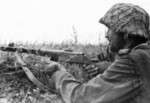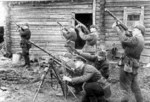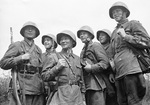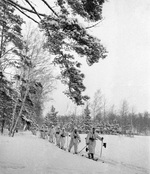PPSh-41 Submachine Gun
| Country of Origin | Russia |
| Type | Submachine Gun |
| Caliber | 7.620 mm |
| Capacity | 71 rounds |
| Length | 843.000 mm |
| Barrel Length | 269.000 mm |
| Weight | 3.630 kg |
| Rate of Fire | 900 rounds/min |
| Range | 200.000 m |
| Muzzle Velocity | 488 m/s |
Contributor: C. Peter Chen
ww2dbaseNote on history of Soviet submachine gun development by Alan Chanter:Georgy Shpagin was a veteran of the Soviet revolutionary war. A weapons repairer turned weapons designer, he drew up the PPSh-41 design with low manufacturing cost, quick production time, and minimum field maintenance in mind. Shpagin's new weapon was first put on trial in Oct 1940, during which it beat weapons designed by proven engineers such as Vasily Degtyaryov, the designer of PPD submachine guns. PPSh-41 could be differentiated from other Soviet submachine guns of the era by the tips of their barrel jackets, which were angle-cut. PPSh-41 was officially adopted for use on 21 Dec 1940 by the Defense Committee of the Council of People's Commissars, and the manufacturing began in Nov 1941. From the outset, PPSh-41 weapons were being produced at a very efficient rate, averaging only 5.6 hours per weapon. By Apr 1942, 155,000 of them had been built, and new weapons were being built at the rate of 3,000 per day.
On the front lines, soldiers of the vast Soviet conscript army regarded "Pah Pah Sha" submachine guns very highly. These weapons were hinged at the magazine housing, making cleaning, critical especially for the environment on the Eastern Front of the European War, very easy. As noted earlier, the construction of PPSh-41 submachine guns was simple, thus damaged PPSh-41 barrels could be replaced by cutting down that of Mosin-Nagant rifles. When compared to Mosin-Nagant rifles, PPSh-41 (and other Soviet submachine guns) had very poor accuracy, but at close range PPSh-41 guns' ability to fire many rounds in the direction of the target, even if scattered, was a clear advantage. PPSh-41 weapons could use either the smaller 35-round box magazines or the larger 71-round drums. While the drums' higher capacity seemed to be favorable on paper, the drums were more difficult to load, very heavy (its unloaded weight was 3.63 kilograms; each box magazine weighed 0.68 kilograms and each drum weighed 1.84 kilograms), and less reliable in battle conditions (the latter was improved in Nov 1943 by increasing the thickness of the metal skin of the drums from 0.3 millimeters to 1 millimeter; this further increased the already heavy weight, however). During the war, over 5,000,000 examples were built. Unlike the Germans which assigned their counterpart MP 40 submachine guns only to specialized platoons, the Soviets equipped entire companies with PPSh-41 submachine guns starting in Jul 1941 to increase infantry firepower. As of Jul 1941, each infantry regiment had a PPSh-41 company with a 7-man headquarters and three 31-man platoons. Perhaps a great tribute to the PPSh-41 weapon was that some German units employed captured PPSh-41 weapons; these captured examples were designated MP 717(r) as-is and MP 41(r) if converted to use 9-millimeter German ammunition.
After WW2, even though all Soviet submachine guns were supplanted by the AK-47 assault rifles, many remained in service for decades to come. In North Korea they were known as Type 59, in Communist China as Type 50, and in Vietnam K-50M (which were converted Communist Chinese Type 50).
Sources:
Chris McNab, Soviet Submachine Guns of World War II
Firearms of the Second World War
The Red Army at War
War Monthly (periodical)
Wikipedia ww2dbase
Last Major Revision: Dec 2007
PPSh-41 Submachine Gun Interactive Map
Photographs
 |  |  |  |
PPSh-41 Timeline
| 20 Dec 1940 | The Defense Committee of the Council of People's Commissars of the Soviet Union officially adopted the PPSh-41 submachine gun. |
Did you enjoy this article or find this article helpful? If so, please consider supporting us on Patreon. Even $1 per month will go a long way! Thank you. Share this article with your friends: Stay updated with WW2DB: |
Visitor Submitted Comments
30 Jun 2009 02:15:40 AM
im looking for a price range on the ppsh-41. i have fired one before but i dont know where to find one. could someone send me a internet site where i would be able to find out?
23 Oct 2009 05:42:07 AM
that was a powerful gun in ww2 its fire rate was almost perfect
11 Apr 2010 07:59:25 PM
The Russians produced about 6,000,000 of the
PPSH-41 sub-machine guns. It was a simple
blowback operating weapon, had a drum magazine of 71 rounds and fired the 7.62x25
pistol round.
The weapon was cheap to make,easy to operate,
and had a chrome-lined chamber, same as the
later AK-47, something the U.S. Army had to
learn later on with its first M-16E1's.
The Russians issued whole units and even
divisions with the weapon.
The weapon had low recoil and was reliable
and effective at close range. The PPSH-41 was
so effective, the Germans also used the weapon, and was converted to fire the 9mm
pistol round, in German service the PPSH-41
was called the MP-41(r)
Fired the 7.62x25 pistol round
Rate-of-Fire 900 rpm
Effective Range 200 Meters
Feed System 71 round drum magazine or a 35 round box magazine.
Fully Automatic Sub-Machine Gun
I was able to fire a PPSH-41 in Vietnam, also
used a Chinese Model Type 56 / AK-47
24 May 2010 10:41:09 AM
I can not belive it holds 71 rownds. I would have accepcted more the that.
30 May 2010 09:37:33 PM
To Anonymous, May 24, 2010 #5
The Russians made 6,000,000 million PPSh-41 submachine guns. The weapon fired 7.62x25mm
Tokarev Cartridge.
Action Blowback, open bolt
Rate of fire 900rpm
Feed system 35 round box magazine,or 71 round
drum magazine.
Effective range 200 meters
Maximum range 400 meters
Service 1941 to the present
The Germans were impressed with the PPSh-41
that they converted the weapon to fire the
7.63x25mm Mauser Cartridge.
1 Jul 2010 07:24:10 PM
Got 1. very reliable and the function is simple.
made in 1945,
can fire the whole drum magazine in only 5-6 seconds.
drum magazine holds 74 rounds.
could not find the box magazine.
6 Oct 2010 07:54:04 PM
I have one never fired it, was given to me by a old ww2 vet. it was in a fire and I am looking for a stock
15 Nov 2010 08:07:02 PM
It was also used by the VA in Vietnam and was nicknamed "The Birp gun".
21 Dec 2010 06:57:30 PM
The ppsh was not nicknamed the birp gun, your thinking of the german mp-40.
16 Feb 2013 12:07:26 PM
i hear they around 20,000.00
10 Feb 2016 02:19:13 PM
hey im just happy to be here
23 May 2016 05:39:47 PM
this gun sucks I managed to get my hands on a trial one at a shooting range and it jammed
every 4 shots give or take a few
17 Jul 2017 11:01:17 PM
How much did the ppsh 41 cost to manufacture individually?
22 Feb 2018 06:29:00 AM
not a very good website
28 Nov 2019 03:45:19 PM
This was us full
All visitor submitted comments are opinions of those making the submissions and do not reflect views of WW2DB.
» Soviet Submachine Guns of World War II
- » 1,150 biographies
- » 337 events
- » 43,917 timeline entries
- » 1,241 ships
- » 350 aircraft models
- » 207 vehicle models
- » 374 weapon models
- » 123 historical documents
- » 260 facilities
- » 470 book reviews
- » 28,541 photos
- » 432 maps
Lt. Gen. Lewis B. "Chesty" Puller, at Guadalcanal
Please consider supporting us on Patreon. Even $1 a month will go a long way. Thank you!
Or, please support us by purchasing some WW2DB merchandise at TeeSpring, Thank you!
16 Feb 2009 05:38:55 PM
The ppsh-41 was used in vietnam, i was able to fire this weapon only one setting, full auto. also picked up chinese model of ak-47 the type 56. had my hands into alot of things